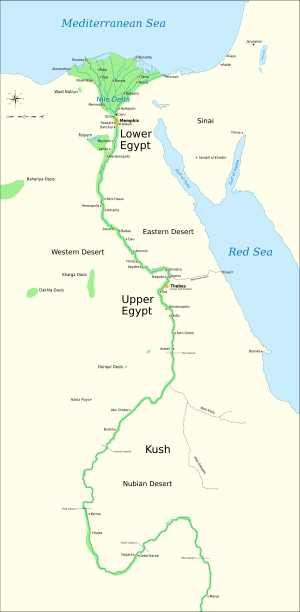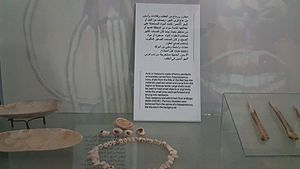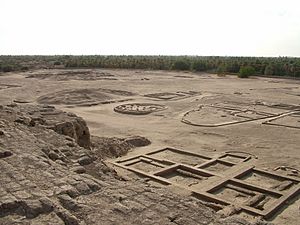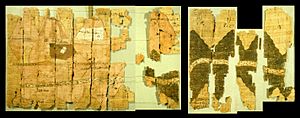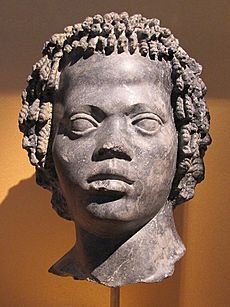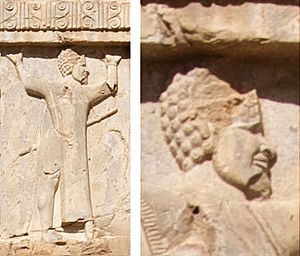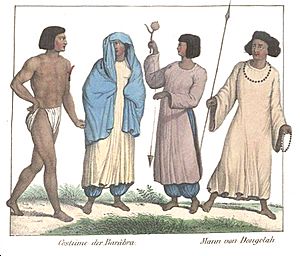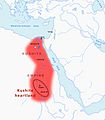Nubia facts for kids
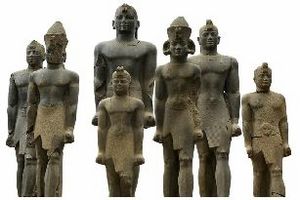
Nubia was an ancient African kingdom that existed for thousands of years, starting around 6000 BC. It was located in northeastern Africa, in what is now parts of Egypt and Sudan.
Nubia was very important because of its strong trading connections. Being near the Red Sea gave them many ports to trade from. However, the Nubian culture faced many challenges. Its power often weakened, causing it to split into smaller kingdoms. These smaller groups are sometimes called the A-Group, B-Group, and C-Group cultures. Nubia's long history finally ended around 350 AD when the kingdom of Axum invaded, breaking up the culture for good.
Today, the land that was once Nubia is divided between the countries of Egypt and Sudan.
Where Was Ancient Nubia?
Nubia was split into three main areas based on their location along the Nile River. These were called Upper, Middle, and Lower Nubia. "Lower" meant closer to the river's mouth (downstream), and "Upper" meant further upstream. Lower Nubia was between the First and Second Cataracts (rocky rapids) and is now part of Egypt. Middle Nubia was between the Second and Third Cataracts. Upper Nubia was south of the Third Cataract.
A Look at Nubia's Past
Early Times in Nubia
The first settlements in Nubia appeared in both Upper and Lower regions. The ancient Egyptians called Nubia "Ta-Seti," which meant "The Land of the Bow." This was because Nubians were known as amazing archers. Today, experts often call the people from this early period the "A-Group" culture. There was also a "pre-Kerma" culture in Upper Nubia, known for its fertile farmland.
People living in the Nile Valley during the Neolithic (New Stone Age) period likely came from Sudan and the Sahara Desert. They shared many cultural ideas with these areas and with Egypt. By 5000 BC, people in Nubia were part of the "Neolithic revolution," which meant they started farming and raising animals. Ancient rock carvings in the Sahara show scenes that might be about a "cattle cult," a type of animal worship common in parts of Africa.
Megaliths (large stone structures) found at Nabta Playa are thought to be one of the world's first astronomical devices, even older than Stonehenge by almost 2,000 years! This shows how advanced early Nubian society was. Around 3500 BC, the A-Group culture appeared. It was very similar to the cultures in predynastic Naqada in Upper Egypt. The A-Group people traded a lot with the Egyptians, as shown by Egyptian goods found in Nubian graves. These goods included gold, copper tools, beads, and pottery.

Around 3300 BC, there's proof of a united Nubian kingdom, possibly centered at Qustul. This kingdom had strong connections with Upper Egypt and might have even helped unite the Nile Valley.
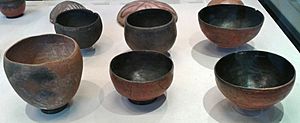
However, around the time Egypt became unified (the protodynastic period), the Egyptians seem to have taken over Ta-Seti (the Qustul kingdom). Nubia then became part of Upper Egypt. By the time of Egypt's first dynasty, the A-Group area seemed to be empty, possibly because people moved away.
The A-Group culture started to decline around 2800 BC. Some experts believe the area was empty from about 3000 BC to 2500 BC, possibly due to Egyptian invasions. Nubia was an important trade route between Egypt and tropical Africa for a long time. Egyptian artists used ivory and ebony wood that came through Nubia.
Around 2300 BC, Nubia was first mentioned in Egyptian records. Egyptians imported gold, incense, ebony, copper, ivory, and exotic animals from tropical Africa through Nubia. As trade grew, so did Nubia's wealth. By the time of Egypt's 6th dynasty, Nubia was split into small kingdoms. The C-Group people, who lived from about 2500 BC to 1500 BC, might have been descendants of the A-Group or new people who moved in. Their pottery is known for its detailed geometric patterns.
During the Egyptian Middle Kingdom (around 2040–1640 BC), Egypt started expanding into Nubia to control trade routes. They built many forts along the Nile. These forts seemed to have peaceful relations with the local Nubians. Another culture, called the Pan Grave culture, also existed at this time, known for their shallow graves.
Nubia and Ancient Egypt's Connections
Some historians believe that early Nubian rulers and Egyptian pharaohs used similar royal symbols. This is supported by similar rock art found in both regions. Ancient Egypt conquered parts of Nubia at different times. But Nubians also conquered Egypt later, ruling as the 25th Dynasty.
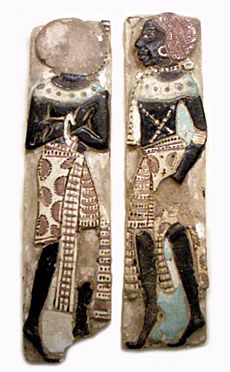
However, Nubians and Egyptians also had peaceful cultural exchanges and even mixed marriages. The Medjay were a group of Nubian people who became part of the Egyptian military, serving as scouts and workers.
During the Middle Kingdom of Egypt, the term "Medjay" started to refer to a tribe of people, not just a region. They were nomadic desert people who eventually joined the Egyptian army. They served as guards in Egyptian forts in Nubia and patrolled the deserts. Later, they became an important part of the Egyptian army, helping in campaigns against invaders like the Hyksos.
By the 18th Dynasty of the New Kingdom, the Medjay were an elite police force. The name "Medjay" then meant "police officer" in general, not just a specific ethnic group. They were known for protecting important places like royal palaces and tombs in Thebes.
Some experts believe that several pharaohs of Nubian origin played important roles in Egyptian history, especially during the 12th Dynasty. These rulers governed like Egyptians, showing the strong cultural ties between the two regions. In the New Kingdom, it became hard to tell Nubians and Egyptians apart in archaeological findings.
The Kerma Kingdom
From the pre-Kerma culture, the first major kingdom in Nubia emerged. This was the Kerma Culture, named after its likely capital city, Kerma. It was one of the earliest urban centers along the Nile and its people spoke Cushitic languages. By 1750 BC, the kings of Kerma were powerful enough to build huge mud-brick walls and structures. They also had rich tombs filled with treasures for the afterlife and even practiced large human sacrifices.
At one point, Kerma almost conquered Egypt. According to some historians, the Kerma forces were so strong that if they had stayed and occupied Egypt, they might have ended the Egyptian nation. But when Egypt's power returned during the New Kingdom of Egypt (around 1532–1070 BC), the Egyptians expanded south. They destroyed Kerma's kingdom and capital, extending the Egyptian empire to the Fourth Cataract.
By the end of Thutmose I's rule (1520 BC), all of northern Nubia was under Egyptian control. The Egyptians built a new center at Napata and used the area to get gold and incense. Nubian gold made Egypt a major source of this precious metal in the Middle East. The difficult conditions for the workers in these gold mines were described by the ancient writer Diodorus Siculus. One of the oldest maps known, the Turin Papyrus Map from about 1160 BC, shows a gold mine in Nubia.
The Kingdom of Kush
The Napatan Period

When the Egyptians left the Napata region, they left behind a strong influence that mixed with local customs. This led to the creation of the kingdom of Kush. The Kushites adopted many Egyptian practices, including their religion. The Kingdom of Kush lasted even longer than ancient Egypt. It even invaded Egypt under King Piye and ruled Egypt for nearly 100 years as the Twenty-fifth Dynasty of Egypt.
The Kushites controlled their northern neighbors until the Assyrians invaded and pushed them south. They then moved their capital to Meroë. Of the Nubian kings from this time, Taharqa is one of the most famous. He was the son and third successor of King Piye. Taharqa ruled both Nubia and Egypt, rebuilt Egyptian temples, and built new temples and pyramids in Nubia before the Assyrians drove him out of Egypt.
The Meroitic Period
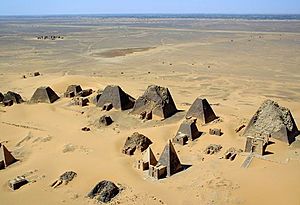
Meroë (800 BC – around 350 AD) was in southern Nubia, on the east bank of the Nile. The people of Meroë kept many ancient Egyptian customs but were also unique. They developed their own writing system, first using Egyptian hieroglyphs and later creating their own alphabet with 23 signs. Kings were buried in Meroë starting with King Arakamani.
Persian Influence and Roman Clashes
The Achaemenids (Persian Empire) might have taken over the Kushan kingdom around 530 BCE, or more likely during the time of Darius I (550-486 BCE), who mentioned conquering Kush in his writings.
The ancient writer Strabo described a battle where the Romans defeated Nubians. After the Kushites advanced, Gaius Petronius, a Roman official in Egypt, led a large army south. The Romans fought the Kushite armies near Thebes and forced them to retreat. Petronius then offered a peace agreement, but when the Kushites didn't respond, he advanced and took their city of Premnis. He continued all the way to Napata, the second capital of Kush, and attacked it, taking its people prisoner.
During this time, Nubia became divided into smaller groups led by different generals. They fought for control, making the whole region weak. Meroë was eventually defeated by the rising Kingdom of Aksum to its south, led by King Ezana.
The Meroitic language is still a bit of a mystery, but it's now thought to be part of the Eastern Sudanic languages. Around the 4th century, the region was conquered by the Noba people, which is possibly where the name Nubia comes from. Another idea is that it comes from the Egyptian word for gold. After this, the Romans called the area Nobatia.
Christian Nubia
Around 350 AD, the Kingdom of Aksum invaded, and the Meroitic kingdom fell apart. Eventually, three smaller Christian kingdoms took its place: Nobatia in the north (between the first and second cataracts), with its capital at Pachoras (Faras); Makuria in the middle, with its capital at Old Dongola; and Alodia in the south, with its capital at Soba (near Khartoum). King Silky of Nobatia defeated the Blemmyes and recorded his victory around 500 AD.
Christianity had reached the region by the 4th century. Records show that a priest named Julian converted the king and nobles of Nobatia around 545 AD. The kingdom of Alodia was converted around 569 AD.
By the 7th century, Makuria grew powerful and became the main kingdom in the region. It was strong enough to stop the southern spread of Islam after the Arabs took over Egypt. After several failed invasions, the new Arab rulers agreed to a treaty with Dongola, called the Baqt. This treaty allowed for peaceful living and trade for 600 years. Over time, more Arab traders came to Nubia, bringing Islam with them, and it slowly replaced Christianity. By the 14th century, the cathedral in Dongola had become a mosque.
The arrival of Arabs and Nubians in Egypt and Sudan led to the decline of Nubian identity after the last Nubian kingdom fell around 1504. Most Nubians today are Muslim, and Arabic is their main language, along with their traditional Old Nubian language. Nubian culture is still unique, seen in their clothing, dances, traditions, and music.
Islamic Nubia and Modern Times
In the 14th century, the government of Dongola collapsed, and the region became divided and controlled by Arabs. Over the next centuries, there were several Arab invasions and new, smaller kingdoms were formed. Northern Nubia came under Egyptian control, while the south was controlled by the Kingdom of Sennar in the 16th century. The entire region eventually came under Egyptian control in the early 1800s under Muhammad Ali, and later became a joint British-Egyptian territory.
Nubia Today
After colonialism ended and Egypt (1953) and Sudan (1956) became independent, Nubia was divided between the two countries.
In the early 1970s, many Egyptian and Sudanese Nubians had to move from their homes to make way for Lake Nasser. This lake was created after the dams were built at Aswan. Today, Nubian villages can be found north of Aswan and on Elephantine Island. Many Nubians also live in big cities like Cairo.
Images for kids
-
11th Dynasty model of Nubian archers in the Egyptian army, from a tomb in Asyut (c. 2130–1991 BC).
-
Nubian Prince Heqanefer bringing tribute for King Tutankhamun, 18th dynasty, Tomb of Huy. Circa 1342 – c. 1325 BC
-
Kushite heartland, and Kushite Empire of the Twenty-fifth Dynasty of Egypt, circa 700 BC.
-
Taharqa's kiosk and column, Karnak temple
-
Jewelry of Kandake Amanishakheto
-
Copy of relief from Naqa depicting Amanitore (second from left), Natakamani (second from right) and two princes approaching a three-headed Apedemak.
-
The Relief of Gebel Sheikh Suleiman probably shows the victory of an early Pharaoh, possibly Djer, over A-Group Nubians circa 3000 BC.
See also
 In Spanish: Nubia para niños
In Spanish: Nubia para niños


